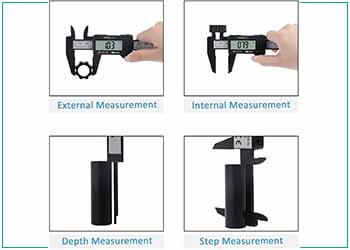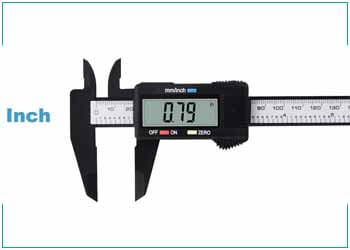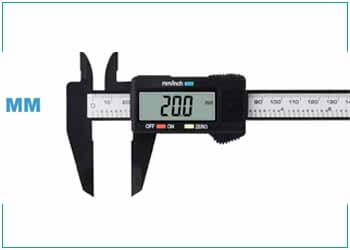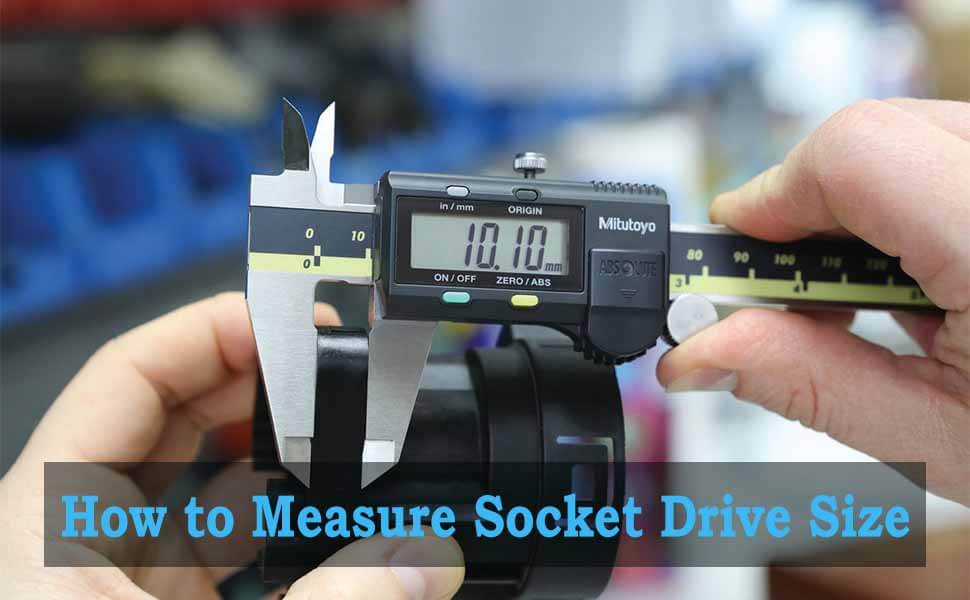Last Updated on January 11, 2023 by TechChecking
Determining the right size socket is essential because without a proper socket drive you cannot fasten or unfasten a nut or bolt. So, knowing how to measure socket drive size can help you find it quickly like an expert. Socket sets are generally sold as a single, box, or pouch containing various replaceable attachments. If you have a whole set of socket drives, you can easily pick the right size if you know the steps on how to measure socket drive. In this article, we will try to focus on how to figure out socket size and how to measure what size socket you need. Let’s get started.
Contents
The Systems to Measure Socket Drive Size
We can measure the socket drive size in two systems. The first one is the Imperial system which is measured by inches and the second one is the Metric system which is measured by millimeters. However, the drive socket size is always calculated using an imperial measurement system. The imperial system maintains an international standard level. So, why don’t we know more about the socket drive size measuring systems? Let’s know some information about it.
The Imperial System
The imperial system of units is an imperial system (also known as British Imperial) which was first defined in the British Weights and Measures Act in 1824. It was then gradually developed through time.
The imperial system developed from earlier English units and the imperial units replaced the Winchester Standards that were in effect from 1588 to 1825. However, the imperial system was considered as official use across the British Empire in 1826.
By the late 20th century, most nations were accustomed to using the metric system as their main system of measurement. But imperial units were still used alongside metric units in the United Kingdom and in some other parts of the former empire, notably Canada.
In this modern age, the practice of using an imperial system is mostly seen in the USA. We also see some best automotive tools are manufactured there. And since the USA supplies the tools and equipment all over the world, the imperial system of measurement has increased exponentially.
As we know imperial system measurement is applied to sockets and wrenches in inches and fractions of an inch. The head size of imperial sockets is usually from 5/32 inches to ½ inches. In fact, these ranges of sizes are mostly and commonly used all over the globe. They follow the standard measurement system.
The Metric System
If we simply follow the history we see that the metric system is a measurement system that had been introduced in France in the 1790s. The metrication (adopting the metric system is known as metrication) was started and a new definition was introduced which is called the International System of Units (SI). This name of SI was established under the oversight of an international standards body in the mid-20th century.
However, through a great evolution and time, metric systems have evolved since the 1790s. It is because science and technology were advancing from then. Before the new system SI was innovated, some other metric systems were followed too. They are the MKS system of units and the MKSA systems, which are the direct forerunners of the SI.
In addition, the metric system has seven base units. They are Meter for length, kilogram for mass, Second for time, Ampere for electric current, Kelvin for temperature, Candela for luminous intensity, and Mole for the amount of substance. To be truthful, these can measure any physical quantity.
Moreover, the metric system measurements are applied to sockets, wrenches, and any tools or equipment as millimeters. The head size of the metric sockets ranges from 3 mm to 80 mm.
How to Measure Socket Drive Size

We have discussed the systems of how to measure socket drive size and now we are going to elaborate on how to measure a nut for a socket size step by step. If you are quite eager to know about “how do I know what size socket I need”, you need to read the whole paras. We will also show the ways of measuring socket drive size in both imperial and metric systems.
To apply this system, you must require a digital caliper to figure out the socket size quickly. Once you have managed the digital caliper, you are ready to follow the next steps.
Imperial System

Step 1: First, turn on the digital caliper. And then set it to inches (not millimeters) for the measure on imperial systems because the imperial system is followed by inches.
Step 2: At step two, put the nut on a flat surface. A table would be good. Now open the jaws of the digital caliper so that it fits perfectly between the nut and the caliper. Set it properly.
Step 3: Close the caliper jaws perfectly making sure each jaw rests on one flat side of the nut on opposite sides.
Step 4: Now take a closer look to get a clear view and check the caliper display. The reading shows the size of the nut as a decimal. We know that imperial sockets are sized following in fractions of an inch. Since you set the caliper to inches, you need to look at the decimal to fraction. You can check the conversion table below.
Important Note: if you don’t find the value of a fraction in accordance with the size of the measured nuts, you should then find the size of the socket in the metric systems. To know how to measure socket drive size in a metric system, follow the next method.
Metric System

Step 1: Turn on the digital caliper. Set it to millimeters to determine the size of the socket drive.
Step 2: Put the nut on a flat surface like a table. Open the jaws of the caliper and try to set it such as it can perfectly fit with the nut. If you think you have done this part successfully, just close the jaws of the caliper on both the flat side of the nuts.
Step 3: Now take a look at the display of the caliper and check it out. The reading shown on the display is the size of the nut as a decimal. We already know that metric sockets are measured in millimeters. You can convert the millimeter to inches just by checking out the table. However, select the first-millimeter size larger than your caliper reading and this is how you can know the size of your nut and required sockets.
Some Quality Digital Caliper
What Is The Standard Socket Wrench Size?
The standard socket wrench size is very common all over the world. The wrench sizes can be different but to be truthful, there are 3 types of common socket sizes available in the market. They are:
- 1/4 inch or 0.6 centimeters
- 3/8 inches or 0.9 centimeters
- 1/2 inch or 1.3 centimeters
Since these socket wrench sizes are different, you can use these for different purposes.
1/4 inches or 0.6 centimeters – this socket wrench size is comparatively small and is used to do small projects as well.
3/8 inches or 0.9 centimeters – the 3/8 inches socket wrench is medium in size. This is a common and popular size. You can do small to medium-type0 jobs easily and comfortably. A very perfect tool specially used for cars.
1/2 inches or 1.3 centimeters – a ½ inch socket wrench size is the largest of those three sizes. These types of wrenches are good for heavy-duty jobs which are commonly used in industrial work. You can tighten or loosen any nut or bolt up to 10 mm easily and effortlessly.
What are the wrench sizes?
There are a lot of wrench sizes out there. Wrench sizes – I think you are meaning different types of Imperial Combination Wrenches and Metric Combination Wrenches by wrench sizes. If that is the point, let’s see some sizes of wrenches.
- Imperial Combination Wrenches (1/4, 5/16, 11/32, 3/8, 7/16, 1/2, 9/16, 5/8, 11/16, 3/4, 13/16, 7 / 8, 15/16, 1)
- Metric Combination Wrenches (6, 7, 8, 9, 10, 11, 12, 13, 14, 15, 16, 17, 18, 19)
- Regular Flare Nut Wrenches (3/8, 7/16, 1/2, 9/16, 5/8, 11/16, 3/4, 7/8)
These are the commonly used wrench sizes. If you have a set of them, you can complete any project at lightning-flash speed.
Metric Socket Sizes Chart
Wrench sizes and wrench sizes in order are important to know. The below table will provide enough data and information to get your work done. We hope, this chart will help you a lot. Let’s take a look.
| 1/4” Drive | 3/8” Drive | 1/2” Drive | 3/4” Drive | 1” Drive |
| 4 mm | 5.5 mm | 8 mm | 19 mm | 36 mm |
| 4.5 mm | 6 mm | 9 mm | 20 mm | 38 mm |
| 5 mm | 7 mm | 10 mm | 21 mm | 41 mm |
| 5.5 mm | 8 mm | 11 mm | 22 mm | 46 mm |
| 6 mm | 9 mm | 12 mm | 23 mm | 50 mm |
| 7 mm | 10 mm | 13 mm | 24 mm | 54 mm |
| 8 mm | 11 mm | 14 mm | 25 mm | 55 mm |
| 9 mm | 12 mm | 15 mm | 26 mm | 58 mm |
| 10 mm | 13 mm | 16 mm | 27 mm | 60 mm |
| 11 mm | 14 mm | 17 mm | 28 mm | 63 mm |
| 12 mm | 15 mm | 18 mm | 29 mm | 65 mm |
| 13 mm | 16 mm | 19 mm | 30 mm | 67 mm |
| 14 mm | 17 mm | 20 mm | 31 mm | 70 mm |
| 15 mm | 18 mm | 21 mm | 32 mm | 71 mm |
| 19 mm | 22 mm | 33 mm | 75 mm | |
| 20 mm | 23 mm | 34 mm | 77 mm | |
| 21 mm | 24 mm | 35 mm | 80 mm | |
| 22 mm | 25 mm | 36 mm | ||
| 26 mm | 38 mm | |||
| 27 mm | 40 mm | |||
| 28 mm | 41 mm | |||
| 30 mm | 42 mm |
Measurements and Conversions
The table below is a conversion table from fractions to decimals and millimeters and vice-versa. Once you measure either the imperial system or the metric system, you can take help from here to convert, for example, inches to millimeters. If you want to more about the table, know from here.
[Remember, I inch = 25.4 mm exactly]
Convert fractions to decimals and millimeters and reverse
| fraction | decimal | mm | fraction | decimal | mm | fraction | decimal | mm |
| 1/64 | 0.0156 | 0.3969 | 1 1/64 | 1.0156 | 25.7969 | 2 1/64 | 2.0156 | 51.1969 |
| 1/32 | 0.0313 | 0.7938 | 1 1/32 | 1.0313 | 26.1938 | 2 1/32 | 2.0313 | 51.5938 |
| 3/64 | 0.0469 | 1.1906 | 1 3/64 | 1.0469 | 26.5906 | 2 3/64 | 2.0469 | 51.9906 |
| 1/16 | 0.0625 | 1.5875 | 1 1/16 | 1.0625 | 26.9875 | 2 1/16 | 2.0625 | 52.3875 |
| 5/64 | 0.0781 | 1.9844 | 1 5/64 | 1.0781 | 27.3844 | 2 5/64 | 2.0781 | 52.7844 |
| 3/32 | 0.0938 | 2.3813 | 1 3/32 | 1.0938 | 27.7813 | 2 3/32 | 2.0938 | 53.1813 |
| 7/64 | 0.1094 | 2.7781 | 1 7/64 | 1.1094 | 28.1781 | 2 7/64 | 2.1094 | 53.5781 |
| 1/8 | 0.1250 | 3.1750 | 1 1/8 | 1.1250 | 28.5750 | 2 1/8 | 2.1250 | 53.9750 |
| 9/64 | 0.1406 | 3.5719 | 1 9/64 | 1.1406 | 28.9719 | 2 9/64 | 2.1406 | 54.3719 |
| 5/32 | 0.1563 | 3.9688 | 1 5/32 | 1.1563 | 29.3688 | 2 5/32 | 2.1563 | 54.7688 |
| 11/64 | 0.1719 | 4.3656 | 1 11/64 | 1.1719 | 29.7656 | 2 11/64 | 2.1719 | 55.1656 |
| 3/16 | 0.1875 | 4.7625 | 1 3/16 | 1.1875 | 30.1625 | 2 3/16 | 2.1875 | 55.5625 |
| 13/64 | 0.2031 | 5.1594 | 1 13/64 | 1.2031 | 30.5594 | 2 13/64 | 2.2031 | 55.9594 |
| 7/32 | 0.2188 | 5.5563 | 1 7/32 | 1.2188 | 30.9563 | 2 7/32 | 2.2188 | 56.3563 |
| 15/64 | 0.2344 | 5.9531 | 1 15/64 | 1.2344 | 31.3531 | 2 15/64 | 2.2344 | 56.7531 |
| 1/4 | 0.2500 | 6.3500 | 1 1/4 | 1.2500 | 31.7500 | 2 1/4 | 2.2500 | 57.1500 |
| 17/64 | 0.2656 | 6.7469 | 1 17/64 | 1.2656 | 32.1469 | 2 17/64 | 2.2656 | 57.5469 |
| 9/32 | 0.2813 | 7.1438 | 1 9/32 | 1.2813 | 32.5438 | 2 9/32 | 2.2813 | 57.9438 |
| 19/64 | 0.2969 | 7.5406 | 1 19/64 | 1.2969 | 32.9406 | 2 19/64 | 2.2969 | 58.3406 |
| 5/16 | 0.3125 | 7.9375 | 1 5/16 | 1.3125 | 33.3375 | 2 5/16 | 2.3125 | 58.7375 |
| 21/64 | 0.3281 | 8.3344 | 1 21/64 | 1.3281 | 33.7344 | 2 21/64 | 2.3281 | 59.1344 |
| 11/32 | 0.3438 | 8.7313 | 1 11/32 | 1.3438 | 34.1313 | 2 11/32 | 2.3438 | 59.5313 |
| 23/64 | 0.3594 | 9.1281 | 1 23/64 | 1.3594 | 34.5281 | 2 23/64 | 2.3594 | 59.9281 |
| 3/8 | 0.3750 | 9.5250 | 1 3/8 | 1.3750 | 34.9250 | 2 3/8 | 2.3750 | 60.3250 |
| 25/64 | 0.3906 | 9.9219 | 1 25/64 | 1.3906 | 35.3219 | 2 25/64 | 2.3906 | 60.7219 |
| 13/32 | 0.4063 | 10.3188 | 1 13/32 | 1.4063 | 35.7188 | 2 13/32 | 2.4063 | 61.1188 |
| 27/64 | 0.4219 | 10.7156 | 1 27/64 | 1.4219 | 36.1156 | 2 27/64 | 2.4219 | 61.5156 |
| 7/16 | 0.4375 | 11.1125 | 1 7/16 | 1.4375 | 36.5125 | 2 7/16 | 2.4375 | 61.9125 |
| 29/64 | 0.4531 | 11.5094 | 1 29/64 | 1.4531 | 36.9094 | 2 29/64 | 2.4531 | 62.3094 |
| 15/32 | 0.4688 | 11.9063 | 1 15/32 | 1.4688 | 37.3063 | 2 15/32 | 2.4688 | 62.7063 |
| 31/64 | 0.4844 | 12.3031 | 1 31/64 | 1.4844 | 37.7031 | 2 31/64 | 2.4844 | 63.1031 |
| 1/2 | 0.5000 | 12.7000 | 1 1/2 | 1.5000 | 38.1000 | 2 1/2 | 2.5000 | 63.5000 |
| 33/64 | 0.5156 | 13.0969 | 1 33/64 | 1.5156 | 38.4969 | 2 33/64 | 2.5156 | 63.8969 |
| 17/32 | 0.5313 | 13.4938 | 1 17/32 | 1.5313 | 38.8938 | 2 17/32 | 2.5313 | 64.2938 |
| 35/64 | 0.5469 | 13.8906 | 1 35/64 | 1.5469 | 39.2906 | 2 35/64 | 2.5469 | 64.6906 |
| 9/16 | 0.5625 | 14.2875 | 1 9/16 | 1.5625 | 39.6875 | 2 9/16 | 2.5625 | 65.0875 |
| 37/64 | 0.5781 | 14.6844 | 1 37/64 | 1.5781 | 40.0844 | 2 37/64 | 2.5781 | 65.4844 |
| 19/32 | 0.5938 | 15.0813 | 1 19/32 | 1.5938 | 40.4813 | 2 19/32 | 2.5938 | 65.8813 |
| 39/64 | 0.6094 | 15.4781 | 1 39/64 | 1.6094 | 40.8781 | 2 39/64 | 2.6094 | 66.2781 |
| 5/8 | 0.6250 | 15.8750 | 1 5/8 | 1.6250 | 41.2750 | 2 5/8 | 2.6250 | 66.6750 |
| 41/64 | 0.6406 | 16.2719 | 1 41/64 | 1.6406 | 41.6719 | 2 41/64 | 2.6406 | 67.0719 |
| 21/32 | 0.6563 | 16.6688 | 1 21/32 | 1.6563 | 42.0688 | 2 21/32 | 2.6563 | 67.4688 |
| 43/64 | 0.6719 | 17.0656 | 1 43/64 | 1.6719 | 42.4656 | 2 43/64 | 2.6719 | 67.8656 |
| 11/16 | 0.6875 | 17.4625 | 1 11/16 | 1.6875 | 42.8625 | 2 11/16 | 2.6875 | 68.2625 |
| 45/64 | 0.7031 | 17.8594 | 1 45/64 | 1.7031 | 43.2594 | 2 45/64 | 2.7031 | 68.6594 |
| 23/32 | 0.7188 | 18.2563 | 1 23/32 | 1.7188 | 43.6563 | 2 23/32 | 2.7188 | 69.0563 |
| 47/64 | 0.7344 | 18.6531 | 1 47/64 | 1.7344 | 44.0531 | 2 47/64 | 2.7344 | 69.4531 |
| 3/4 | 0.7500 | 19.0500 | 1 3/4 | 1.7500 | 44.4500 | 2 3/4 | 2.7500 | 69.8500 |
| 49/64 | 0.7656 | 19.4469 | 1 49/64 | 1.7656 | 44.8469 | 2 49/64 | 2.7656 | 70.2469 |
| 25/32 | 0.7813 | 19.8438 | 1 25/32 | 1.7813 | 45.2438 | 2 25/32 | 2.7813 | 70.6438 |
| 51/64 | 0.7969 | 20.2406 | 1 51/64 | 1.7969 | 45.6406 | 2 51/64 | 2.7969 | 71.0406 |
| 13/16 | 0.8125 | 20.6375 | 1 13/16 | 1.8125 | 46.0375 | 2 13/16 | 2.8125 | 71.4375 |
| 53/64 | 0.8281 | 21.0344 | 1 53/64 | 1.8281 | 46.4344 | 2 53/64 | 2.8281 | 71.8344 |
| 27/32 | 0.8438 | 21.4313 | 1 27/32 | 1.8438 | 46.8313 | 2 27/32 | 2.8438 | 72.2313 |
| 55/64 | 0.8594 | 21.8281 | 1 55/64 | 1.8594 | 47.2281 | 2 55/64 | 2.8594 | 72.6281 |
| 7/8 | 0.8750 | 22.2250 | 1 7/8 | 1.8750 | 47.6250 | 2 7/8 | 2.8750 | 73.0250 |
| 57/64 | 0.8906 | 22.6219 | 1 57/64 | 1.8906 | 48.0219 | 2 57/64 | 2.8906 | 73.4219 |
| 29/32 | 0.9063 | 23.0188 | 1 29/32 | 1.9063 | 48.4188 | 2 29/32 | 2.9063 | 73.8188 |
| 59/64 | 0.9219 | 23.4156 | 1 59/64 | 1.9219 | 48.8156 | 2 59/64 | 2.9219 | 74.2156 |
| 15/16 | 0.9375 | 23.8125 | 1 15/16 | 1.9375 | 49.2125 | 2 15/16 | 2.9375 | 74.6125 |
| 61/64 | 0.9531 | 24.2094 | 1 61/64 | 1.9531 | 49.6094 | 2 61/64 | 2.9531 | 75.0094 |
| 31/32 | 0.9688 | 24.6063 | 1 31/32 | 1.9688 | 50.0063 | 2 31/32 | 2.9688 | 75.4063 |
| 63/64 | 0.9844 | 25.0031 | 1 63/64 | 1.9844 | 50.4031 | 2 63/64 | 2.9844 | 75.8031 |
| 1″ | 1.0000 | 25.4000 | 2″ | 2.0000 | 50.8000 | 3″ | 3.0000 | 76.2000 |
What is the Drive Size of a Socket?
¼ inches, 3/8 inches, and ½ inches are the three common drive sizes of the socket are available. These are the most common sizes that you can find all over the world. They offer a metric socket set.
These are 3 different sizes. The smallest one (¼ inches) is good for small-sized nuts and bolts. The medium one (3/8 inches) is good for fastening and unfastening medium-sized nuts and bolts and the biggest one (½ inches) is used for tightening or loosening the bigger nuts or bolts.
If you want bigger than a ½” drive size, a 1” drive size of a socket is available too. So, you can tell the most common socket sizes are 1/4″, 3/8″, 1/2″, 3/4″, or 1″.
Frequently Asked Questions
1. What are the standard wrench sizes?
Wrench sizes are different to deal with different sizes of nuts or bolts. However, the standard key is in sizes 1/4, 5/16, 11/32, 3/8, 7/16, 1/2, 9/16, 5/8, 11/16, 3/4, 13/16, 7/8, 15/16, and 1.
2. How are the traffic jams in the correct order?
The traffic jams should be in the correct order. They are (1/2 inch) 3/8 inch, 7/16 inch, 1/2 inch, 9/16 inch, 5/8 inch, 11/16 inch, 3/4 inch, 13 / 16 inch, 7/8 inch, 15/16 inch, 1 inch, 11/16 inch, 11/8 inch, 13/16 inch, 11/4 inch.
3. How many contacts are there in a set?
Well, you can see the contact points in standard sockets. They are used for the best gripping of a nut. The Standard Sockets (5/32, 3/16, 7/32, 1/4, 9/32, 5/16, 11/32, 3/8, 7/16, 1/2, and 9/16 inch) 12 6-point metric sockets (4, 5, 5.5, 6, 7, 8, 9, 10, 11, 12, 13 and 14mm) 10 12pt.
4. What are the standard output sizes in the order?
The standard output sizes in the order are:
Standard Allen keys (5/16, 11/32, 3/8, 7/16, 1/2, 9/16, 5/8, 11/16, 3/4, 13/16)
Metric socket wrenches (8, 9, 10, 11, 12, 13, 14, 15, 16, 17, 18, 19, 20, 21)
Deep six-point metric contacts (8, 9, 10, 11, 12, 13, 14, 15, 16, 17, 18, 19)
Standard Hex Box (5/32, 3/16, 7/32, 1/4, 5/16, 3/8)
5. What are the dimensions of Allen?
Allen keys are generally measured in fractional size and metric size. The three most common sizes are probably 5/32”, 3/16”, and ¼”. In metric sizes, 4, 5, and 6 mm seem like a lot of stock. Other good SAE sizes are 3/32”, 7/64 “, 1/8”, 9/64” and 7/32”.
Final Words
We hope that the answer is now clear on how to measure socket drive size. We have tried to cover everything you need to know about how to measure socket drive size. Supporting questions are also mentioned there. Questions like how do I know what size socket I need, how to measure what size socket you need, how to figure out socket size, how to measure socket drive, how do you measure socket drive size, etc. are the same questions. You can take the same answers that we have discussed here. If you have any queries please let us know. You know how to reach out to us.
Articles You May Like –
- Wrench Sizes In Order
- Different Types of Wrenches and Their Uses
- Monkey Wrench vs Pipe Wrench
- How to Use a Socket Wrench
- Different Types Of Socket Wrenches

